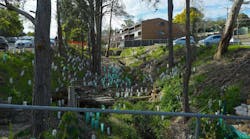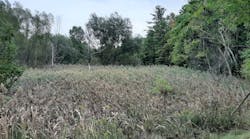Ten years ago, the United States Army Corps of Engineers of the Galveston (TX) District faced huge problems. They thought, planned, reworked plans, and generally burned the midnight oil, trying to figure out the best way to enlarge the Houston and Galveston Ship Channels. In addition, they pondered kid-glove ways to handle enraged environmentalists and property owners opposed to enlargements. And then there was another greatly troublesome problem: how to dispose of millions of cubic yards of channel dredge. But that was yesterday. Today the corps is reaping the fruits of victory.
These days, a half-billion-dollar enlargement program is in place and is being touted by waterway experts for its potential for ship safety and economic benefits. In a nutshell, the 50-mi. Houston Ship Channel (HSC) is being widened to 530 ft. and deepened to 45 ft. Improvements on the Galveston Ship Channel are being delayed until funding can be obtained.
“This will be one of our biggest projects this century,” remarks corps spokesman Ken Bonham in the November 29, 1999, edition of the Galveston Daily News. “It’s a major step forward for shipping safety. If you can imagine the ships that are passing through the channel, you’ve got to take your hat off to the people who know how to drive them. That extra 130 feet will make a big difference.”
The environmental group has put its unqualified blessing on taking the millions of cubic yards of channel dredge and creating 4,500 ac. of marshes for wildlife habitats. As a result, people from all over the world are visiting the Houston area to study the ecosystems marsh project, the largest of its kind in the country.
More than 7,000 ships use the HSC annually. The Port of Houston is number one in the US in foreign tonnage and second in total tonnage.
The April 7, 1999, ceremony, held at Wharf 31 of the Houston Port, followed the actual start of three dredge construction contracts earlier in the day. “In all, the corps, which has designed and is managing the enlargement project, has let nine dredge contracts,” states Bonham.
The flag-flying ceremony kicked off with booms from a replica of a Civil War cannon. The ceremony was reminiscent of a 1914 ceremony held at Bayou Bay in Houston to mark the opening of the HSC. Attending the ceremony were corps military brass, congressional delegates from Washington, DC-including US Senators Phil Gramm and Kay Bailey Hutchison and House Representative Tom DeLay-Houston Mayor Lee Brown, many Houstonians, and dredging-industry people. Representing the corps was Brigadier General J. Arnold of the Southwestern Division Engineers. He commented on the countless benefits that the enlarged HSC will bring, including ship safety and a boon to economy and ecosystems.
Arnold also complimented the Beneficial Uses Group, a subcommittee responsible for making healthy marshes out of dredge material. After praising the many people who had helped to make the enlargement possible, Arnold said, “This is a great day for the Houston Port Authority and the Texas Congressional Delegation. For the Corps of Engineers it’s a great day to be a soldier and an engineer.” DeLay, the House Whip, gave his endorsement, saying the broadened channel would be great for competitive trade.The HSC is a breed of canal that permits ocean-going ships to move to and from an inland port. It’s located east of downtown Houston, a city of nearly 4 million people. Basically, the channel is dredged between Buffalo Bayou to the west and Galveston Bay to the southeast. Lined up along the HSC are oil refineries, pipelines, storage facilities, and petrochemical plants. It is also home to the nation’s largest petrochemical complex, valued at $15 billion.
Along the HSC, which handled an estimated 160 million tons during 1997, are the Turning Basin, the Bayport Terminal, and Barbour’s Court. “Joined with these, the channel forms the heart of the Port of Houston,” points out one navigational authority. Principal commerce includes petroleum, chemicals, ore, grains, cotton machinery, and general cargo.
Galveston-population 239,300-is a city and port of entry in southeastern Texas, situated on the eastern end of Galveston Island. Both transoceanic freighters and passenger ships dock at Galveston. The Port of Galveston exports much of the area’s cotton, wheat, and sulfur. It is also a transshipment point for such products as raw sugar and bananas. Nearby Pelican Island is a well-developed industrial site.
Development of the Demonstration Project
More than 10 years ago, the corps came up with a plan to enlarge the Houston and Galveston Ship Channels. Unfortunately, the plan was not well received. “A firestorm of protests broke out,” recalls Richard Gorini, executive vice president of Houston-based J. Simmons Group Inc., a project management consulting firm for the Port of Houston.
“In 1989 it looked like we were never going to get the project built,” remarks Rosie Barrera, port spokesperson. Environmental skeptics and homeowners, as well as proponents of the plan, were peppering the local papers and TV programs with their opinions. The corps scheduled meetings and invited supporters and nonsupporters. “When we first started our talks, nobody wanted to come,” says Dalton Krueger, a project manager in the corps’ Galveston district. “But then we got around to having ‘kitchen-table’ meetings,” Gorini adds. In the informal kitchen setting, people began to throw around all kinds of ideas. Some were really different, he recalls, noting that those people who were most opposed to an idea would point out how it could be made to work.
The kitchen-table meetings began to spark more general interest, and the corps came up with a brilliant idea. It invited representatives from about 12 federal and state organizations to form an interagency coordination team (ICT). Among the organizations represented were the Texas Parks and Wildlife Department, the US Fish and Wildlife Department, the national Marine Fisheries Services, and the US Environmental Protection Agency.
ICT proved a master stroke. Opinions in the group were very carefully considered. Next, as they began to think seriously of the feasibility of building marshes out of dredge materials, the Beneficial Uses Group (BUG) subcommittee was formed from eight ICT members. The idea that was pulling out strongly in front was to make 4,500 ac. of marsh out of channel dredge. “We began to call the dredge material ‘resource material,'” says Gorini. “You can do a lot with dredge. It really should be thought of as a resource.”
ICT and BUG started a 220-ac. demonstration project. They divided the marsh locations into 1-ac. plots and planted a different kind of vegetation in each to see which worked best. Then BUG began to test every idea for enlarging the channels and building marshes out of dredge. It was agreed that the project would go first-class in contracts for tests. Here are some examples:
Contaminants Study. Chemical analyses, bioassays, and bioaccumulation tests were completed. Based on the results, the Contaminant Subcommittee concluded there were no contamination concerns with material to be dredged from the channel. The subcommittee recommended to ICT that the material was acceptable for beneficial use. ICT has approved the use of the dredged material.
Oyster Model Study. This numerical modeling effort, which is nearing completion, models the life cycle of the oyster. The model was developed by Texas A&M University and Old Dominion University (Norfolk, VA) and is coupled with the hydrodynamic and salinity models. The model study evaluated the impact of the proposed channel improvement on oysters and identified the appropriate sites for the mitigation areas. One hundred and eighteen ac. of oyster reefs are to be built as mitigation areas for oyster beds discovered on the sides of the existing channel.
Cumulative Impact Study. In the past, impacts to the bay have been addressed by each project, but not as a cumulative impact.
Beneficial Uses of Dredged Material Study. This study investigated all possible uses for the dredged material. BUG has developed a dredged material plan for the bay and offshore reaches. This plan puts all the material dredged from the channel to beneficial use or into confined upland sites. ICT has approved the BUG plan as the disposal plan for the project.
One of the people who was most concerned about the project was Linda Snead, executive director of the Galveston Bay Foundation, a conservation group. Snead says she had been concerned about where the material would be dumped, salinity in the bay, and the toxicity of the dredged material.
Among the reassuring reports given to the foundation were ones showing that dredged material would be taken from the open-water (rather than the inland) part of the bay where there was no contamination. After the foundation learned about the tests and studies, it did a 180º turn. It now sees the dredge project as a benefit to the economy and the environment. Speaking of the HSC dredging project and the creation of marshes, the Galveston Daily News ran a story headlined “It’s a Win-Win Situation” (December 8, 1998).
As the testing drew to a close, the corps and others involved issued a statement: “The overall performance of the ICT process has been outstanding. The agencies that participated in the process have worked very hard to identify the appropriate procedures needed.”
Behind the HSC scenes these days, dredging companies are busily fulfilling their contracts. The four-year-old dredging project will run from 1998 to 2002. So far nine contracts have been let and $100 million paid out. In the next two years, this amount could double. According to an article by Andrew Rae in the Engineering News-Record of April 26, 1999, traditional as well as innovative practices are being used in the dredging operation.
“We’re enlarging one segment of Galveston Bay, building a 200-acre marsh in the bay, and building a bird island,” says Michael Ernst, division engineer for Great Lakes Dredge and Dock Company. Based in Oak Brook, IL, the company holds a $52.5-million contract.
Ernst’s company is doing something a little unusual. “We’re utilizing marsh flotation backhoes, which we rent from another company. This machine floats while we’re pumping the very soft, wet material.”
Ernst mentions another unusual feature of this operation: “We’re placing the machine in Galveston Bay, which is open water.” It’s a challenge to contain the marsh material in open water. “We’re also utilizing a spill barge in connection with the construction of bird island.” He explains that a spill barge has a pipe that extends about 100 ft. off the end and that is cantilevered to swing around and place material where it’s needed. The company is also using a global positioning system to properly locate bird island in the marsh area.Bean Stuyvesant, based in Belle Chasse, LA, has recently completed a $10.8-million contract to widen and enlarge the channel. It also has a $28.7-million contract to extend the channel into the Gulf of Mexico. “We’re working about 12 to 14 miles offshore,” explains Ancil Taylor, vice president and general manager. “Basically we’re taking dredge out of the channel and depositing it in an underwater berm. It’s designed to reduce wave energy. It’s something the people on Galveston Beach will never see since it’s all underwater. But it will diminish the wave action and protect what little sand they have left on the beach.”
The Stuyvesant dredge vessel is the largest dredge in the US. It can suck up enough mud from the HSC to fill the equivalent of 500 dump trucks every two hours. An innovative feature of the Stuyvesant dredge is a special mechanical device. “It lies on the bottom of the seabed,” describes Taylor. “It’s shaped somewhat like a cowcatcher on a train, and it’s designed to gently push the turtles out of the way.” The channel project started a little bit behind schedule because the dredged material earmarked for the project was diverted to the Mississippi River, which had been damaged by this season’s hurricane, Taylor states.
William Shaw, vice president of Luhr Brothers in Columbia, IL, points out, “We’re a marine contractor and handle a variety of projects.” The company’s $14.8-million contract includes six 20-ac. oyster reefs consisting of 2- to 3-ft. beds of crushed limestone. Shaw says it’s ticklish work because they are making unusually thin reefs. Renda Marine Inc. in Dallas, TX, holds a $12.5-million contract to dredge the upper portions of Buffalo Bayou. It’ll use its ace dredge, Millennium.
Although the Houston-Galveston expansion is considered a remarkable, blow-your-mind project by many experts, there are certain negatives. For example, one expensive drawback is the pipeline removal that’s taking place. Ninety-two pipelines have been identified for removal or relocation. One pipeline has already been relocated by Black Martin, a division of Enron Corporation. Its new line is operating, and removal of the old line is complete. This line comes from Bolivar and crosses the ship channel midbay. Those companies that have removal and relocation permits include Florida Gas Transmission, Equilon Pipeline, and Chevron Pipeline.
To get an idea of the detailed approach the corps takes, look at some of the specifications it has issued:
- A Corps of Engineers permit is required if a pipeline is to be abandoned, replaced, or relocated.
- Pipelines to be abandoned must be cleaned to avoid any contamination to the environment.
- A pipeline labeled for removal shall be completely removed to appropriate limits outside the channel.
- No closure of channel to vessel traffic is permitted.
- The Coast Guard requires lighting on floating pipeline during pipeline removal or placement.
Another downside of the channel expansion is that residents’ homes or business property is expected to diminish in value. “Who wants a ship going by your front yard?” asks one unhappy homeowner. In addition, big, big bucks have been necessary to launch HSC. It’s believed, however, that accommodating larger ships and providing more safety will outweigh the negatives.
ICT is scheduled to be active for the next 50 years. It has been so successful in this project that it was used as a model for problem-solving in the environmentally sensitive Laguna Madre area in south Texas. Other groups are considering adopting ICT techniques. ICT predicts that 130 million yd.3 of dredged material will be removed from the channel by the project’s end in 2002.
In all, HSC is proving to be an outstanding accomplishment. In the next few years many people from the dredging industry are expected to visit and observe the work in action. They will come with their families, shoot photos, take notes, and swim. Perhaps they’ll take a free tour of the channel and then eat at Shanghai Red’s restaurant and watch tugs push big ships through the channel. Many will visit the sea wall and walk the beach.
On the Houston-Galveston Online Resource Center Web site (www.swg.usace.army.mil/hgnc/), you’ll find a project history, maps of construction areas, construction schedules, and more. If you have any questions, contact the Public Affairs Office, US Army Corps of Engineers, Galveston District, PO Box 1229, Galveston, TX 77553-1229; 409/766-3004 (ph); 409/766-3049 (fx); [email protected] (e-mail).


